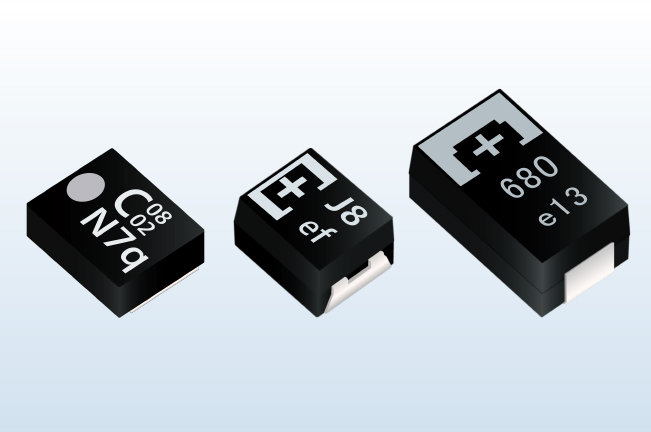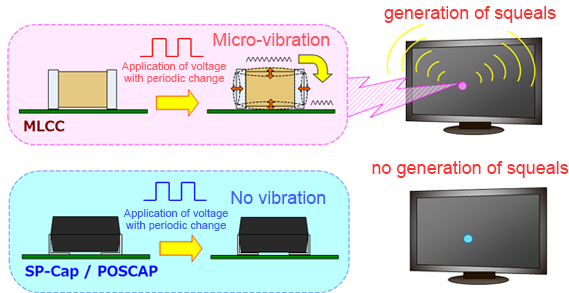POSCAP utilizes sintered Tantalum as an anode sytem and highly conductive polymer created with Panasonic's unique method as a cathode system. This enabled POSCAP to be thin, small and at the same time have low ESR (Equivalent Series Resistance) and superior high frequency characteristics. These features make POSCAP one of the best candidates for digital/high frequency applications. POSCAP also has high reliability and heat resistance.
Topics
- 2025-05-08 We have expanded the product numbers of the TQC series (3 product numbesr) and TDC series (3 product numbers).
- 2025-04-01 The TPB series (1 part number)is NOT recommended for new designs.
- 2025-01-10 We have expanded the product numbers of the TQC series (3 product numbesr) and TDC series (3 product numbers).
- 2024-10-31 The TQC (1 part number) has been discontinued.
- 2024-10-21 The TPF series (1 part number), TPC series (1 part number), TQC series (1 part number), TPE series (2 part numbers), and TPB series (2 part numbers) are NOT recommended for new designs.
- 2024-04-25 One new part item has been added to the TQS series.
- 2024-04-25 Production of TPG series and TLE series has been discontinued.
- 2024-04-25 Production of TQC / TH / TPE series (1 item number each), TPF series (2 product numbers) and TPC series (9 product numbers) has been discontinued.
- 2024-04-25 TPF / TCF / TQS series (1 item number each) is NOT Recommended for New Design.
- 2024-01-31 Production of TA (1 product number), TPF (1 product number) and TQC (7 product numbers) has been discontinued.
- 2024-01-10 One new part item has been added to the TQC series.
- 2023-12-11 One new part item has been added to the TQS series.
- 2023-12-11 TQT series has been commercialized.
- 2023-06-30 Production of TPE (5 product numbers) and TPG (9 product numbers) has been discontinued.
- 2023-04-21 Some parts of TPE(3 part numbers)、TPF(1 part number) series, and TH series are Not Recommended for New Design.
- 2022-11-08 The TLE series has been commercialized.
- 2022-07-05 The part number of TDC series has been added (2 part number).
- 2021-11-02 TPE series(4 part numbers),TPG series(9 part numbers) are Not Recommended for New Design.
- 2021-07-09 The part number of TPB series has been added (4 part number).
- 2021-07-09 The part number of TPC series has been added (4 part number).
- 2021-07-09 The part number of TPF series has been added (12 part number).
- 2021-07-09 The part number of TPS series has been added (1 part number).
- 2021-07-09 The part number of TQC series has been added (4 part number).
- 2021-04-28 The part number of TC series has been added (1 part number).
- 2020-11-30 The part number of TQC series has been added (2 part number).
- 2020-10-01 TPU series and TPH series has been discontinued.
- 2020-10-01 TQS series 3 part numbers (B1S size) are Not Recommended for New Design.
- 2020-09-30 The part number of TQC series has been added (3 part number).
- 2020-07-30 The TPS series has been commercialized.
- 2020-06-30 The part number of TQS has been added (1 part number).
- 2019-08-28 The TDC series (125°C,1000h guarantee) has been commercialized.
- 2018V~11-14 TPU & TPH are Not Recommended for New Design.
- 2018V~11-07 Conductive Polymer Tantalum Solid Capacitors (POSCAP) page has been updated.
- 2018V~06-18 The part number of TPB has been added (1 part number).
- 2018V~06-18 The part number of TQC has been added (1 part number).
- 2018V~03-23 The part number of TPE has been added (79 → 83 part number).
- 2017-10-27 The part number of TPE has been added (77 → 79 part number).
- 2017-04-04 The design support tool " Characteristic Viewer" has been posted
- 2016-10-28 Registration certificates of quality and environment certifications (ISO, TS) are available for download
- 2016-07-24 "Cross reference" has been posted
Features
- ■ Lead free
- Terminal plating is Palladium and Gold. It's completely lead free.
- ■ Low profile chip capacitor
- ■ Low impedance and low ESR at high frequency※
- ■ High ripple current capability
- ■ Long Life 105°C*2,000Hrs*
- ■ Excellent noise-absorbent characteristics
- ■ Excellent temperature characteristics up to .55°C
- ■ The rush current is guaranteed for 20A
- ■ Superior to Ta-Cap in safety
*A part of the model is excluded.
Measures against problems with electrolytic capacitors and general tantalum capacitors
- Noise measure
- Ignition measure
- Low profile / Space-saving
Conductive products can solve the problem
1. Noise
Noise measure
Noise measure
- General tantalum
aluminum electrolytic capacitors
High ripple by high ESR 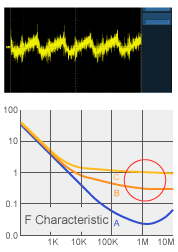
- Conductivity
Low ripple by low ESR 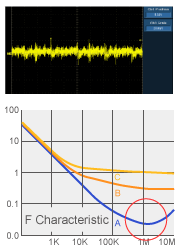
2. Safety(compared to general tantalum capacitors)
Ignition measure
Ignition measure
- Overvoltage test General tantalum capacitors
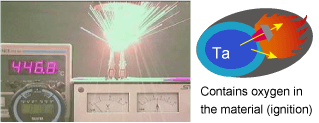
- Ignition by overvoltage
- Overvoltage test Conductive capacitors
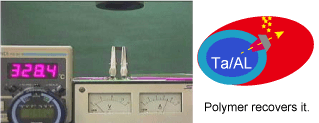
- Safety with self-recovery function
3. Space
Low profile Space-saving
Low profile
Space-saving
■Low profile

- aluminum electrolytic capacitors


- SP-Cap / POSCAP

■Space-saving(Reduced space by 70%)
- General tantalum



- SP-Cap / POSCAP

Measures against problems in ceramic capacitors (MLCC)
- Quantity/Cost reduction
- Rudeness prevention / Anti-vibration
- Crack prevention measures
- Safety measure
Conductive products can solve the problem
1. Insufficient capacitance
Quantity/Cost reduction
Quantity/Cost reduction
- Capacitance of MLCC is reduced by Voltage application + Low temperature/High temperature


2. Squeaking / Micro vibration
Rudeness prevention Anti-vibration
Rudeness prevention
Anti-vibration
- MLCC
Expansion and contraction of
element by Piezo effect
(Generation of micro vibrations)
SP-Cap / POSCAP
No vibration 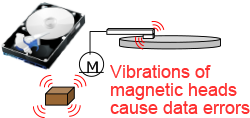
3. Cracks
Crack prevention measure
Crack prevention measure
- MLCC is cracked by temperature/mechanical impact
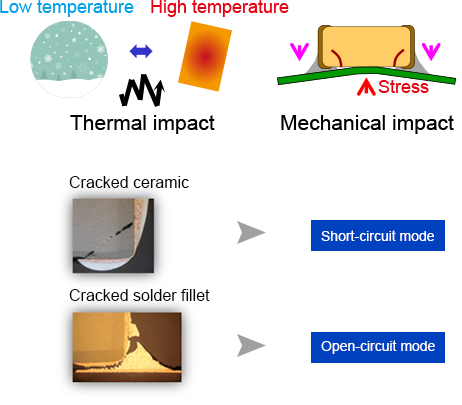
4. Fire spreading to board
Safety measure
Safety measure
The red heat continues if MLCC is short-circuited.
- MLCC

- Fire broadly spread to the board around MLCC

- SP-Cap

- No red heat
- SP-Cap/POSCAP swells or burns, but less spreading of fire

Application to be used
POSCAP is used in the following applications from the lineup of the low profile and the small size.
Of course the conductive polymer characteristic (low ESR etc.) is included, too.
- A main purpose of use : Low profile
The backup circuit of SSD - A main purpose of use : Small size
The battery line of smartphone - Others
USB charger and USB output terminal, LCD panel, etc.

Related articles
- Basic Knowledge of Capacitors (1)
- Basic Knowledge of Capacitors (2)
- Basic Knowledge of LC Filters
- Solving Problems with MLCCs by Adopting Conductive Polymer Capacitors
- Noise-reducing measures start with knowing about the different types and properties of noise.
- Noise Management using Capacitors: Effectiveness of Conductive Polymer Electrolytic Capacitors
